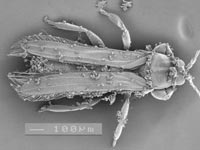This article is reposted from the old Wordpress incarnation of Not Exactly Rocket Science. The blog is on holiday until the start of October, when I'll return with fresh material.
 For plants too, sex can be a hot and smelly affair. In most plant-insect partnerships, the pollinator seems to do most of the work by voluntarily transferring pollen from plant to plant in exchange for a meal.
For plants too, sex can be a hot and smelly affair. In most plant-insect partnerships, the pollinator seems to do most of the work by voluntarily transferring pollen from plant to plant in exchange for a meal.
But an ancient lineage of plants - the cycads - takes more active steps to ensure its future with a bizarre combination of heat and smells. In the afternoon, they use heat and a toxic stench to drive insects out of male cones only to lure them into female cones in the evening with a more alluring scent.
Cycads were around before the time of the dinosaurs and their six-legged puppets are a group of similarly ancient insects called thrips. The thrips make their homes among the single large cone that sits atop the cycad trunk, looking like an enormous pine cone.
The thrips prefer the male ones, for their cracks are laden with nutritious pollen that the insects and their larvae eat. But their lodgings aren't free. Irene Terry and colleagues from the University of Utah found that the cycads manipulate them into earning their keep.
When the time comes to pollinate, the cycad cones heat up. By rapidly metabolising stores of fats, sugars and starches, they can raise the temperature of the cones to 12C above the surrounding temperature, up to about 37C.
 The cones stay hot between 11am and 3pm and the increased temperature triggers the release of a barrage of odours, comprised mostly of a chemical called beta-myrcene.
The cones stay hot between 11am and 3pm and the increased temperature triggers the release of a barrage of odours, comprised mostly of a chemical called beta-myrcene.
Terry tested the effect of this chemical on thrips by placing them in a Y-shaped tube with beta-myrcene pumping down one arm. She found that the chemical attracts the insects at low levels but strongly repels them at high levels. If thrips that wandered down the odourless arm were suddenly exposed to high concentrations of beta-myrcene, they either fled or died within 10 minutes.
The goal behind the cycad's chemical blitz was clear. Concentrated beta-myrcene is toxic to thrips and the insects flee the cones to avoid it, taking grains of pollen with them. Terry describes the smell as "harsh and overwhelming" and the thrips clearly think so too.
Later on in the evening, the cones cool down and stop releasing beta-myrcene. The previously repellent chemical dissipates and at low levels, it (along with other pleasant-smelling odours) summons the thrips back into the cones. Those that enter female cones bring valuable pollen with them and fertilise the cycads.
Terry believes that the thrips that enter female cones are duped. Obviously, they have no pollen rewards awaiting them but Terry believes that the female ones fool the thrips into thinking that they are males by mimicking the right smells.
 While it seems like the cycads are doing the manipulating, the reality is that the fates of both species are totally intertwined. The thrips eat nothing but cycad pollen, and the cycads have no other pollinators besides the thrips.
While it seems like the cycads are doing the manipulating, the reality is that the fates of both species are totally intertwined. The thrips eat nothing but cycad pollen, and the cycads have no other pollinators besides the thrips.
Terry believes that this "push-pull pollination strategy" may have been an intermediate step in the evolution of insect pollination. That theory is certainly bolstered by the fact that both thrips and cycads are very evolutionarily ancient groups.
The first flowering plants were pollinated by the wind, and odours were used only to deter plant predators. In this case, the cycad uses repulsive smells to manipulate insects in its quest for sex.
More on pollination:
- Orchid lures in pollinating wasps with promise of fresh meat
- Tiny treeshrews chug alcoholic nectar without getting drunk
- Of flowers and pollinators - a case study of punctuated evolution
- Flowers change colour and back again to advertise their opening hours
Reference: Terry,. Walter, Moore, Roemer & Hull. 2007. Odor-mediated push-pull pollination in cycads. Science 318: 70.




There are a few more species of thrips than there are of mammals, and as much variation among them.
Not sure about your assertion Nathan- I understand there to be about 5,000 species of thrips in the Order Thysanoptera and about 5,500 species of mammal distributed through 29 different Orders...
The count of extant arthropod species is far from complete; of tetrapods, nearly so. "Order" is a purely artificial, and formally meaningless, construct. Thrips have had way longer to invent variations than mammals have. Entomologists like to say that if mammalogists went by entomological standards, mammals would all be in one genus, because they're all practically identical.
Nathan, I agree with the entomological metaphor in your second comment- my point was not an issue of classification or taxonomy, rather simply one of accuracy- I have no doubt whatsoever that there probably are several thousand hemimetabolous insects yet to be properly classified amongst the hundreds of thousands yet to be "discovered" (and based on current biodiversity, at a ratio of at least 175 insects for every mammal), but I am neither Terry Erwin nor E.O. Wilson and can therefore only comment on what I know to be true rather than what may eventually be proven...!
Make that 5,502...! LOL!
http://www.independent.co.uk/environment/nature/163-new-species-found-i…